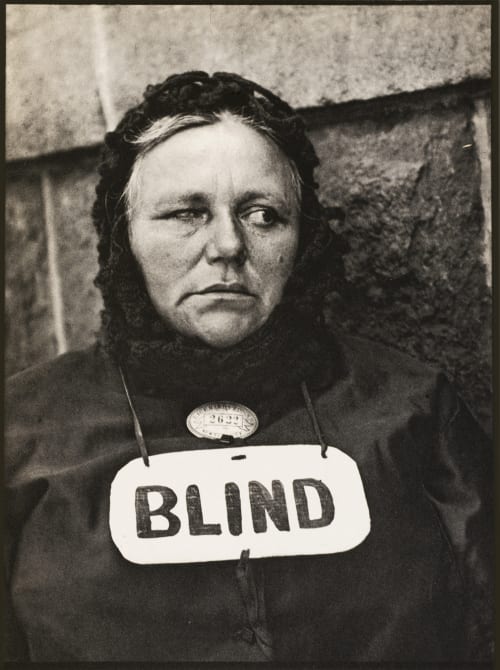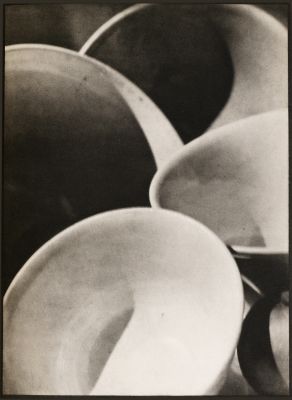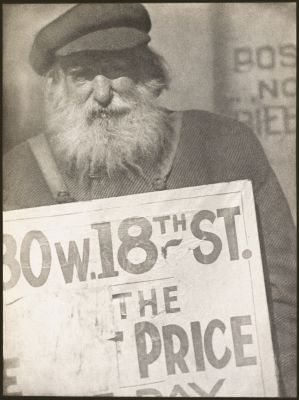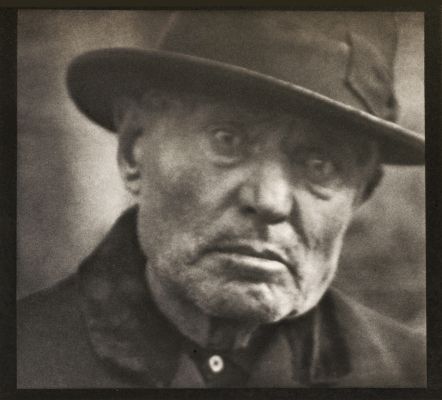
Title
Photograph – New YorkArtist
Strand, Paul (American, 1890-1976)Key FigurePublication
Camera Work XLIX/LDate
1917Process
PhotogravureImage Size
21.9 x 16.4 cm
Strand took his street photographs with a trick camera that led people to believe he was shooting in another direction. His portraits of the poor were not part of a social reform program, but intended to be matter-of-fact examples of life. His audience would not have known about the trick but they would have understood the picture’s ironic slant, namely the contrast between the camera’s clear eye and the woman’s blindness. [1]
While he was in high school in New York City, Paul Strand studied photography with Lewis Hine, the social reformer and photographer. He also frequented Alfred Stieglitz’s Little Galleries of the Photo-Secession—later known as "291" for its address on Fifth Avenue—where he quickly absorbed the lessons of modern European art through the work of Picasso, Brancusi, and Cézanne, among others. In 1916, Strand made a series of candid street portraits with a handheld camera fitted with a special prismatic lens, which allowed him to point the camera in one direction while taking the photograph at a ninety-degree angle. This seminal image of a street beggar was published in 1917 as a gravure in Stieglitz’s magazine Camera Work and immediately became an icon of the new American photography, which integrated the objectivity of social documentation with the boldly simplified forms of modernism. [2]
Reproduced / Exhibited
Doty, Robert M. Photo-secession: Photography As a Fine Art. N.Y: Eastman, 1960. p. 64.
Foster, Sheila J, Manfred Heiting, and Rachel Stuhlman. Imagining Paradise: The Richard and Ronay Menschel Library at George Eastman House, Rochester. Göttingen: Steidl, 2007 p. 213
Frizot, Michael. New History of Photography. Place of publication not identified: Pajerski, 1999. Print p. 332
Gernsheim, Helmut. Creative Photography. Aesthetic Trends 1839-1960. [with Illustrations.]. London: Faber & Faber, 1962. p. 153
Greenough, Sarah, and William C. Agee. Modern Art and America: Alfred Stieglitz and His New York Galleries ; [catalog of an Exhibition Held at the National Gallery of Art, Washington, D.C., 28 January – 22 April 2001]. Washington: National Gallery of Art, 2000. no. 83.
Heilbrun, Françoise. Towards Photojournalism. Paris: Musée d’Orsay, 2007. no. 58.
Homer, William I. Alfred Stieglitz and the American Avant-Guarde. Boston: New York Graphic Society, 1979. no. 124.
Marien, Mary W. Photography: A Cultural History. Englewood Cliffs, NJ: SunSoft Press, 2002. fig. 4.42.
Pollack, P. The Picture History of Photography: From the Earliest Beginnings to the Present Day. New York: Harry N. Abrams, Inc, 1998.253.
Roth, Andrew, and Richard Benson. The Book of 101 Books. New York: 2001 p. 42
Stange, Maren, Robert Adams, and Alan Trachtenberg. Paul Strand: Essays on His Life and Work. New York: Aperture, 1990. no. 1.
Stieglitz, Alfred, Richard Whelan, and Sarah Greenough. Stieglitz on Photography: His Selected Essays and Notes. New York, NY: Aperture Foundation, 2000. p. 225
References
[1] Marien, Mary W. Photography and Its Critics: A Cultural History, 1839-1900. Cambridge: Cambridge University Press, 2011.
[2] "Paul Strand: Blind". In Timeline of Art History. New York: The Metropolitan Museum of Art, 2000–.www.metmuseum.org. http://blog.fotomuseum.ch/2015/02/1-the-problematic-politics-of-paul-strand/#more-2214









